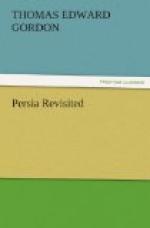Xenophon mentions that the royal emblem of Persia from early times was a golden eagle with outstretched wings, resting on a spearhead like the Roman eagle, but he makes no allusion to a standard. Persian historians tell of a famous standard carried from the mythical time of Zohak to that of the last of the Pehlevi kings. Their story is that Kawah, a blacksmith, raised a successful revolt against the implacably cruel King Zohak in the earliest time of Persian sovereignty, and relieved the country from his terrible tyranny by putting him to death. The victorious blacksmith then placed on the throne Faridun, a Prince of the Peshdadian dynasty, who adopted his apron, which had been the standard of revolt, as the royal banner of Persia. As such it was said to be richly ornamented with jewels, to which every king, from Faridun to the last of the Pehlevi monarchs, added. It was called the Durafsh-i-Kawah[1] (the Standard of Kawah), and continued to be the royal standard of Persia till the Mohammedan conquest, when it was taken in battle by Saad-e-Wakass, and sent to the Khalif Omar. Malcolm said that the causes which led to the sign of Sol in Leo becoming the arms of Persia could not be distinctly traced, but thought there was reason to believe that the use of this symbol was not of very great antiquity. He said, with reference to it being upon the coins of one of the Seljukian dynasty of Iconium, that when this family was destroyed by Halaku, the grandson of Chengiz, it was far from improbable that that Prince or his successor adopted this emblematical representation as a trophy of his conquest, and that it has remained ever since among the most remarkable of the royal insignia of Persia. He also mentioned the opinion that this representation of Sol in Leo was first adopted by Ghiat-u-din-Kai-Khusru-bin-Kai-Kobad, 1236 A.D., and that the emblem is supposed to have reference either to his own horoscope or that of his Queen, who was a Princess of Georgia. This approaches the legend told by the Malik-ut-Tujjar of Tehran, for the face depicted on Sol is that of a woman.




